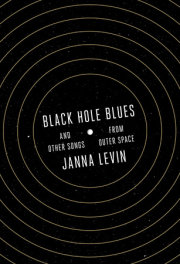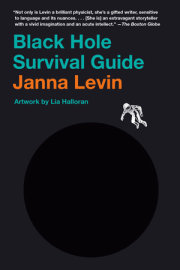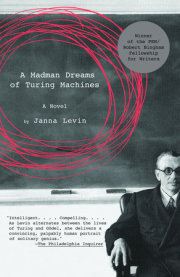Excerpt1
When Black Holes Collide
Somewhere in the universe two black holes collide—as heavy as stars, as small as cities, literally black (the complete absence of light) holes (empty hollows). Tethered by gravity, in their final seconds together the black holes course through thousands of revolutions about their eventual point of contact, churning up space and time until they crash and merge into one bigger black hole, an event more powerful than any since the origin of the universe, outputting more than a trillion times the power of a billion Suns. The black holes collide in complete darkness. None of the energy exploding from the collision comes out as light. No telescope will ever see the event.
That profusion of energy emanates from the coalescing holes in a purely gravitational form, as waves in the shape of spacetime, as gravitational waves. An astronaut floating nearby would see nothing. But the space she occupied would ring, deforming her, squeezing then stretching. If close enough, her auditory mechanism could vibrate in response. She would hear the wave. In empty darkness, she could hear spacetime ring. (Barring death by black hole.) Gravitational waves are like sounds without a material medium. When black holes collide, they make a sound.
No human has ever heard the sound of a gravitational wave. No instrument has indisputably recorded one. Traveling from the impact as fast as light to the Earth could take a billion years, and by the time the gravitational wave gets from the black hole collision to this planet, the din of the crash is imperceptibly faint. Fainter than that. Quieter than can be described with conventional superlatives. By the time the gravitational wave gets here, the ringing of space will involve relative changes in distance the width of an atomic nucleus over a stretch comparable to the span of three Earths.
A campaign to record the skies began a half century ago. The Laser Interferometer Gravitational-Wave Observatory (LIGO) is to date the most expensive undertaking ever funded by the National Science Foundation (NSF), an independent federal agency that supports fundamental scientific research. There are two LIGO observatories, one in Hanford, Washington, and the other in Livingston, Louisiana. Each machine frames 4 square kilometers. With integrated costs exceeding a billion dollars and an international collaboration of hundreds of scientists and engineers, LIGO is the culmination of entire careers and decades of technological innovation.
The machines were taken offline over the past few years for an upgrade to their advanced detection capabilities. Everything was replaced but the nothing—the vacuum—one of the experimentalists told me. In the meantime, calculations and computations are under way in groups across the world to leverage predictions of the universe at its noisiest. Theorists take the intervening years to design data algorithms, to build data banks, to devise methods to extract the most from the instruments. Many scientists have invested their lives in the experimental goal to measure “a change in distance comparable to less than a human hair relative to 100 billion times the circumference of the world.”
In the hopefully plentiful years that follow a first detection, the aspiration is for Earth-based observatories to record the sounds of cataclysmic astronomical events from many directions and from varied distances. Dead stars collide and old stars explode and the big bang happened. All kinds of high-impact mayhem can ring spacetime. Over the lifetime of the observatories, scientists will reconstruct a clanging discordant score to accompany the silent movie humanity has compiled of the history of the universe from still images of the sky, a series of frozen snapshots captured over the past four hundred years since Galileo first pointed a crude telescope at the Sun.
I follow this monumental experimental attempt to measure subtle shifts in the shape of spacetime in part as a scientist hoping to make a contribution to a monolithic field, in part as a neophyte hoping to understand an unfamiliar machine, in part as a writer hoping to document the first human-procured records of bare black holes. As the global network of gravity observatories nears the final stretch of this race, it gets harder to turn attention away from the promise of discovery, although there are still those who vehemently doubt the prospects for success.
Under the gloom of a controversial beginning and the opposition of powerful scientists, grievous internal battles, and arduous technological dilemmas, LIGO recovered and grew, hitting projections and escalating in capability. Five decades after the experimental ambition began, we are on the eve of the crash of a colossal machine into a wisp of a sound. An idea sparked in the 1960s, a thought experiment, an amusing haiku, is now a thing of metal and glass. Advanced LIGO began to record the skies in the fall 2015, a century after Einstein published his mathematical description of gravitational waves. The instruments should reach optimum sensitivity within a year or two, maybe three. The early generation of machines proved the concept, but still success is never guaranteed. Nature doesn’t always comply. The advanced machines will lock on and tolerate adjustments and corrections and calibrations and wait for something extraordinary to happen, while the scientists push aside their doubts and press toward the finish.
As much as this book is a chronicle of gravitational waves—a sonic record of the history of the universe, a soundtrack to match the silent movie—it is a tribute to a quixotic, epic, harrowing experimental endeavor, a tribute to a fool’s ambition.
2
High Fidelity
At 6:00 pm the building is quiet for an MIT headquarters. I have to wait outside until a graduate student rolls up and pops off a bicycle to let me in the locked doors, carrying the bike with her up the stairs. “Rai’s office is straight down.” She points to the hall behind her and wheels away, one foot jumped into the stirrup of the pedal, the other hanging on the same side. She hops off again and is inhaled by a pale office door. Rai’s door looks exactly the same and I have the sense it would be easy to mistake offices, like mistaking hotel rooms.
Rainer Weiss waves me in. We skip conventional social openers and speak with familiarity, although this is our first meeting, as though we’ve known each other for as long as imaginable, the shared experience of our scientific community outweighing a shared hometown or even generation. We lean back in mismatched chairs, our feet propped up on a single stool.
“I started life with one ambition. I wanted to make music easier to hear. As a kid I was in the revolution of high fidelity. Because, look, I was a kid in around 1947. I built hi-fis of the first kind. The immigrants that came to New York, most of them were very eager to listen to classical music.
“See that loudspeaker there? That came from a movie theater in Brooklyn. Behind the screen you had a matrix of those things. I had twenty of them. I lugged them all on the subway. They had a huge fire at the Brooklyn Paramount, and they were getting rid of them. So I had what were movie-studio quality loudspeakers and I had this fantastic circuit that I was building and I had FM radio. And I would invite friends over to listen to the New York Philharmonic and it was unbelievable. You felt like you were in the theater. An unbelievable sound came out of those things.”
Rai gestures to the conical metal guts of a circa 1935 speaker. The raw frame has an exaggerated heft that design advances have banished but otherwise looks surprisingly technologically recent, more 1970s indulgence than 1930s necessity. The object fits in visually with the other metal frames from various apparatuses that are stashed around the hive of scientists attending to a gravitational instrument that first imposed itself as a compelling thought experiment in the 1960s. Although he would later find out he wasn’t the first, Rai dreamed up a device to record the sound of spacetime ringing. A paragon of scientific ambition, the experiment is now too colossal for this building or even for Cambridge, Massachusetts. An R&D laboratory to develop some of the machines’ components is housed in the basement of the building next door, while the fully integrated instruments are constructed on remote sites.
In 2005, Rai molted the venerable role of professor of physics at MIT so he could walk 4 kilometer cement tunnels, affix oscilloscopes to laser beam tubes, appraise 18,000 cubic meters of hard vacuum for leaks, and measure seismic vibrations in dank wasp-infested enclosures. Rai seceded essentially for the privilege to reemerge as a student again but with the elevation of the august title offered the most admired retired—but active—faculty: professor emeritus.
Copyright © 2016 by Janna Levin. All rights reserved. No part of this excerpt may be reproduced or reprinted without permission in writing from the publisher.












